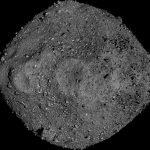Why asteroid Bennu has so craggy surface
Scientists thought asteroid Bennu's surface would be like a sandy beach, abundant in fine sand and pebbles, which would have been perfect for collecting...
Scientists discover a “window” to the early solar system
The dwarf planet Vesta is helping scientists better understand the earliest era in the formation of our solar system.
Two recent papers involving scientists from...
This extreme exoplanet is even more exotic, shows study
The fiery exoplanet WASP-76b – a so-called hot Jupiter, where it rains iron – may be hotter than previously thought.
Considered an ultra-hot Jupiter –...
Scientists discover our solar system’s fastest-orbiting asteroid
The Sun has a new neighbor that was hiding in plain twilight.
An asteroid that orbits the Sun in just 113 days—the shortest known orbital...
Scientists discover new tardigrade fossil in 16-million-year-old amber
Tardigrades, also known as water bears, are a diverse group of charismatic microscopic invertebrates that are best known for their ability to survive extreme...
Pluto’s atmosphere is disappearing, shows study
When Pluto passed in front of a star on the night of August 15, 2018, a Southwest Research Institute-led team of astronomers had deployed...
Some of the Moon’s craters are so dark, it takes ai to see what’s...
There is no dark side of the Moon.
But there are dark spots on it – specifically at the bottom of craters that are never...
Rogue planets could be habitable, shows study
The search for potentially habitable planets is focused on exoplanets—planets orbiting other stars—for good reason.
The only planet we know of with life is Earth...
‘Mini psyches’ give insights into mysterious metal-rich near-earth asteroids
Metal-rich near-Earth asteroids, or NEAs, are rare, but their presence provides the intriguing possibility that iron, nickel and cobalt could someday be mined for...
Scientists may have discovered first planet to orbit 3 stars
In a distant star system — a mere 1,300 light years away from Earth — UNLV researchers and colleagues may have identified the first...










